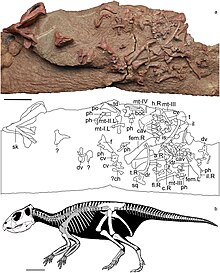Mosaiceratops
| Mosaiceratops | |
|---|---|

| |
| Known material | |
| Scientific classification | |
| Domain: | Eukaryota |
| Kingdom: | Animalia |
| Phylum: | Chordata |
| Clade: | Dinosauria |
| Clade: | †Ornithischia |
| Clade: | †Ceratopsia |
| Infraorder: | † Neoceratopsia
|
| Genus: | †Mosaiceratops Zheng, Jin & Xu, 2015 |
| Species: | †M. azumai
|
| Binomial name | |
| †Mosaiceratops azumai Zheng, Jin & Xu, 2015
| |
Mosaiceratops is a genus of
Although phylogenetic analyses have found Mosaiceratops to be the most basal neoceratopsian, the authors noted that several features in the premaxilla and nasal bones are shared with Psittacosaurus, indicating that neoceratopsians evolved premaxillary teeth twice and that Psittacosaurus is not as primitive as previously thought.[1]
Discovery

On the westbank of the river Tuanhe in
In 2015, the type species Mosaiceratops azumai was named and described by Zheng Wenjie, Jin Xingsheng and Xu Xing. The generic name Mosaiceratops means "mosaic horned face", which refers to the mosaic of features normally found on basal neoceratopsians, psittacosaurids and other basal ceratopsians, especially the lack of premaxillary teeth. It is a combination of Latin mosaicus and Greek keras, "horn" and ops, "face". The specific name honours the Japanese paleontologist Yoichi Azuma, the discoverer of Archaeoceratops.[1] Mosaiceratops was one of eighteen dinosaur taxa from 2015 to be described in open access or free-to-read journals.[2]
The holotype, ZMNH M8856, was found in a layer of the Xiaguan Formation dating from the
Description

Mosaiceratops was a relatively small dinosaur, reaching 1 m (3.3 ft) in length and 10 kg (22 lb) in body mass.

Furthermore a unique combination is present of traits that in themselves are not unique. The premaxilla is
More in general, the skull overall is more similar to advanced taxa like Aquilops or Liaoceratops.[1]
Classification
Zheng et al. (2015), the describers of Mosaiceratops, recovered the genus as the most basal known neoceratopsian, closer to
See also
References
- ^ a b c d e f g h Zheng, W., Jin, X., & Xu, X. (2015). A psittacosaurid-like basal neoceratopsian from the Upper Cretaceous of central China and its implications for basal ceratopsian evolution. Scientific reports, 5. article number 14190: 1-9; doi:10.1038/srep14190
- ^ "The Open Access Dinosaurs of 2015". PLOS Paleo.
- OCLC 985402380.
- ^ Fenglu Han; Catherine A. Forster; Xing Xu; James M. Clark (2017). "Postcranial anatomy of Yinlong downsi (Dinosauria: Ceratopsia) from the Upper Jurassic Shishugou Formation of China and the phylogeny of basal ornithischians". Journal of Systematic Palaeontology. in press. doi:10.1080/14772019.2017.1369185.
